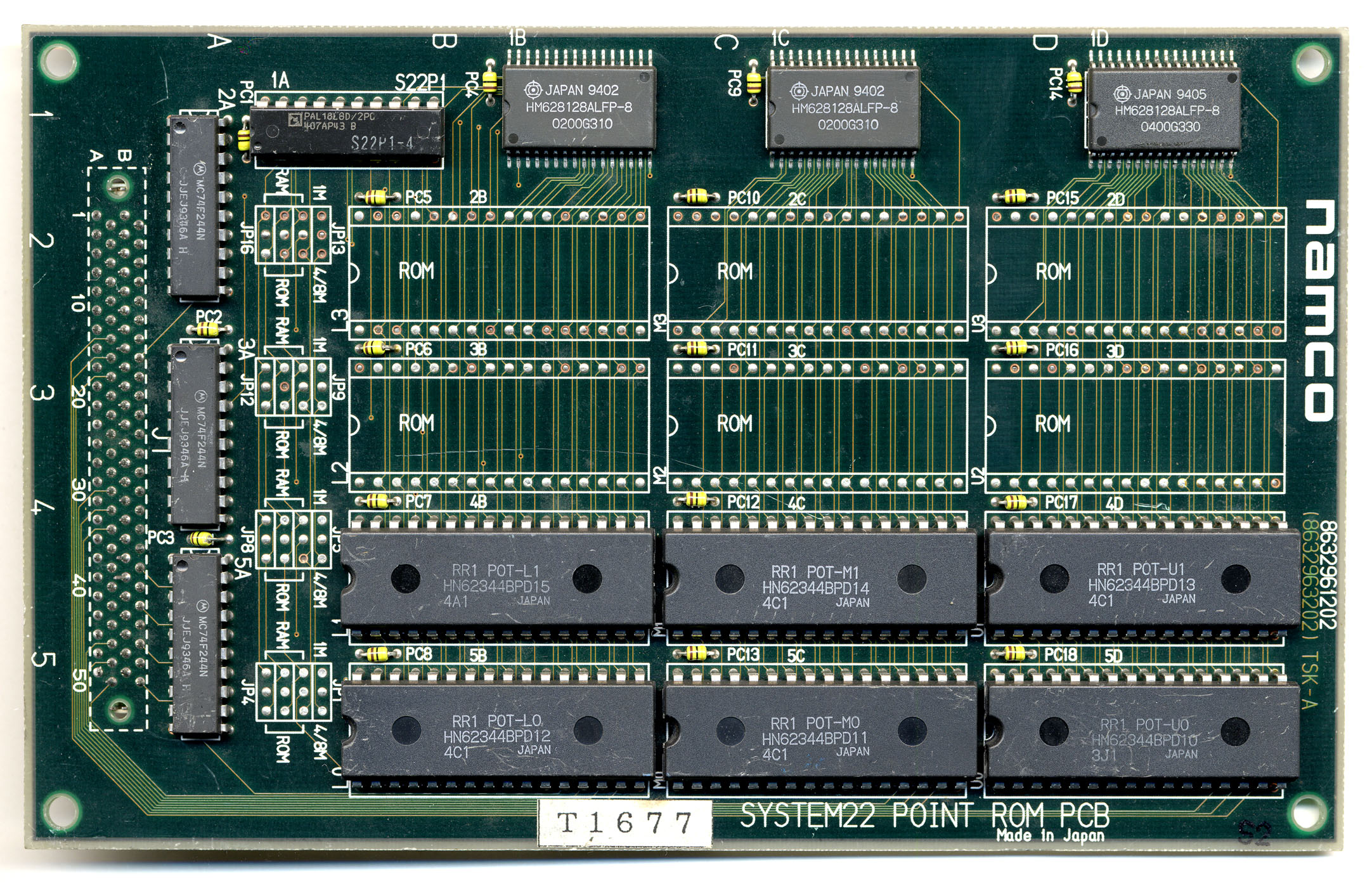|
Air Combat (arcade Game)
is a 1993 combat flight simulator arcade video game developed by Namco. The arcade game was released in 1993 for the polygon-powered Namco System 21 arcade hardware, and received praise for its 3D graphics and technological capabilities. The game was a commercial success at Japanese and American arcades in the 1990s, and inspired several later Namco games, including the arcade sequel ''Air Combat 22'', the PlayStation game ''Air Combat'', and the ''Ace Combat'' series. Gameplay The player is given the task of eliminating all 6 enemy aircraft within a minute. The only enemies in the game are bombers and fighter jets. Bombers are slower, and fighter jets are faster. The player is also given three options for difficulty: Cadet, Captain, and Ace. The differences between the modes are as follows: * In Cadet mode, the player has to eliminate 3 bombers and 3 fighter jets * In Captain mode, the player has to eliminate 2 bombers and 4 fighter jets * In Ace mode, all of the enemy aircra ... [...More Info...] [...Related Items...] OR: [Wikipedia] [Google] [Baidu] |
Namco
was a Japanese multinational corporation, multinational video game and entertainment company, headquartered in Ōta, Tokyo. It held several international branches, including Namco America in Santa Clara, California, Namco Europe in London, Namco Taiwan in Kaohsiung, and Shanghai Namco in mainland China. Namco was founded by Masaya Nakamura (businessman), Masaya Nakamura on June 1, 1955, as beginning as an operator of coin-operated amusement rides. After reorganizing to Nakamura Seisakusho Co., Ltd. in 1959, a partnership with Walt Disney Productions provided the company with the resources to expand its operations. In the 1960s, it manufactured Electro-mechanical game, electro-mechanical arcade games such as the 1965 hit ''Periscope (arcade game), Periscope''. It entered the video game industry after acquiring the struggling Japanese division of Atari, Inc., Atari in 1974, distributing games such as ''Breakout (video game), Breakout'' in Japan. The company renamed itself Namco ... [...More Info...] [...Related Items...] OR: [Wikipedia] [Google] [Baidu] |
3D Graphics
3D computer graphics, or “3D graphics,” sometimes called CGI, 3D-CGI or three-dimensional computer graphics are graphics that use a three-dimensional representation of geometric data (often Cartesian) that is stored in the computer for the purposes of performing calculations and rendering digital images, usually 2D images but sometimes 3D images. The resulting images may be stored for viewing later (possibly as an animation) or displayed in real time. 3D computer graphics, contrary to what the name suggests, are most often displayed on two-dimensional displays. Unlike 3D film and similar techniques, the result is two-dimensional, without visual depth. More often, 3D graphics are being displayed on 3D displays, like in virtual reality systems. 3D graphics stand in contrast to 2D computer graphics which typically use completely different methods and formats for creation and rendering. 3D computer graphics rely on many of the same algorithms as 2D computer vector graphics ... [...More Info...] [...Related Items...] OR: [Wikipedia] [Google] [Baidu] |
Cyber Sled
is a two-player 3D vehicle combat shooter game released by Namco for arcades in 1993. The game's perspective is third-person by default, but can be switched to a first-person perspective. The game was nominated for Most Innovative New Technology at the 1994 AMOA Awards. It later received a sequel in 1994, ''Cyber Commando''. Gameplay ''Cyber Sled'' involves maneuvering a hovercraft style tank through a futuristic arena and fighting to eliminate an opponent (either another player or the computer). Various power-ups are available throughout the game, which feature improved radar, extra missiles, and shield re-charging. There are walls and other obstacles in the arena, which can be useful for hiding as well as a hindrance, and some of which can be destroyed. Each player can choose from among eight different tanks, which vary from slow but heavily shielded, to quick but vulnerable. Player's viewpoint can be either from the cockpit, or from behind the vehicle. Each player has t ... [...More Info...] [...Related Items...] OR: [Wikipedia] [Google] [Baidu] |
Ridge Racer (1993 Video Game)
is a 1993 racing video game developed and published by Namco. It was released initially on the Namco System 22 arcade system board and ported to the PlayStation (console), PlayStation console in 1994. It is the first title in the Ridge Racer, ''Ridge Racer'' series released for arcade game, arcades and home consoles. The aim is to finish in first place in a series of races. The PlayStation version supports Namco's NeGcon controller. Development took eight months, and the game is based on a trend among Japanese car enthusiasts, which involves racing on mountain roads while Drifting (motorsport), drifting around corners. It was also the first arcade video game with 3D texture-mapped graphics, with its System 22 hardware capable of texture mapping and Gouraud shading. The first home version was released in Japan in 1994 as a Launch game, launch title for the PlayStation; the versions for North America and Europe were released in 1995, also as a launch title for both regions. It w ... [...More Info...] [...Related Items...] OR: [Wikipedia] [Google] [Baidu] |
Future US
Future US, Inc. (formerly known as Imagine Media and The Future Network USA) is an American media corporation specializing in targeted magazines and websites in the video games, music, and technology markets. Headquartered in New York City, the corporation has offices in: Alexandria, Virginia; Minneapolis, Minnesota; and Washington, D.C. Future US is owned by parent company, Future plc, a specialist media company based in Bath, Somerset, England. History The company was established when Future plc acquired struggling Greensboro ( N.C.) video game magazine publisher GP Publications, publisher of ''Game Players'' magazine, in 1994. The company launched a number of titles including ''PC Gamer'', and relocated from North Carolina to the San Francisco Bay Area, occupying various properties in Burlingame and South San Francisco. When Chris Anderson, the founder of Future plc, sold Future to Pearson plc he retained GP, renamed Imagine Media, Inc. in June 1995, and operated it as h ... [...More Info...] [...Related Items...] OR: [Wikipedia] [Google] [Baidu] |
GamesRadar+
''GamesRadar+'' (formerly ''GamesRadar'') is an entertainment website for video game-related news, previews, and reviews. It is owned by Future plc. In late 2014, Future Publishing-owned sites ''Total Film'', '' SFX'', ''Edge'' and '' Computer and Video Games'' were merged into ''GamesRadar'', with the resulting, expanded website being renamed ''GamesRadar+'' in November that year. Format and style ''GamesRadar+'' publishes numerous articles each day. Including official video game news, reviews, previews, and interviews with publishers and developers. One of the site's features was their "Top 7" lists, a weekly countdown detailing negative aspects of video games themselves, the industry and/or culture. Now, they are better known for lists of baddest depth segmented by genre, platform, or theme. These are divided into living lists, for consoles and platforms that are still active, and legacy lists, for consoles and platforms that are no longer a target for commercial game deve ... [...More Info...] [...Related Items...] OR: [Wikipedia] [Google] [Baidu] |
PlayStation (console)
The (abbreviated as PS, commonly known as the PS1/PS one or its codename PSX) is a home video game console developed and marketed by Sony Computer Entertainment. It was released in Japan on 3 December 1994, in North America on 9 September 1995, in Europe on 29 September 1995, and in Australia on 15 November 1995. As a fifth-generation console, the PlayStation primarily competed with the Nintendo 64 and the Sega Saturn. Sony began developing the PlayStation after a failed venture with Nintendo to create a CD-ROM peripheral for the Super Nintendo Entertainment System in the early 1990s. The console was primarily designed by Ken Kutaragi and Sony Computer Entertainment in Japan, while additional development was outsourced in the United Kingdom. An emphasis on 3D polygon graphics was placed at the forefront of the console's design. PlayStation game production was designed to be streamlined and inclusive, enticing the support of many third-party developers. The console proved ... [...More Info...] [...Related Items...] OR: [Wikipedia] [Google] [Baidu] |
Namco Super System 22
The Namco System 22 is the successor to the Namco System 21 arcade system board. It debuted in 1992 with '' Sim Drive'' in Japan, followed by a worldwide debut in 1993 with ''Ridge Racer''. The System 22 was designed by Namco with assistance from graphics & simulation company Evans & Sutherland. Graphical features include texture mapping, Gouraud shading, transparency effects, and depth cueing, thanks to the Evans & Sutherland 'TR3' chip/chipset, which stands for: Texture Mapping, Real-Time, Real-Visual, Rendering System. The main CPU provides a scene description to the TR3 graphics processing unit and a bank of DSP chips which perform 3D calculations. A variant of the system, called the Super System 22, was released in 1995. The hardware was largely similar to the System 22, but with a slightly higher polygon rate and more special effects possible. System 22 Specifications *Main CPU: Motorola 68020 32-bit @ 24.576 MHz *DSP: 2x Texas Instruments TMS32025 @ 49.152& ... [...More Info...] [...Related Items...] OR: [Wikipedia] [Google] [Baidu] |
Flight Sim
A flight simulator is a device that artificially re-creates aircraft flight and the environment in which it flies, for pilot training, design, or other purposes. It includes replicating the equations that govern how aircraft fly, how they react to applications of flight controls, the effects of other aircraft systems, and how the aircraft reacts to external factors such as air density, turbulence, wind shear, cloud, precipitation, etc. Flight simulation is used for a variety of reasons, including flight training (mainly of pilots), the design and development of the aircraft itself, and research into aircraft characteristics and control handling qualities. The term "flight simulator" may carry slightly different meaning in general language and technical documents. In past regulations it referred specifically to devices which can closely mimic the behavior of aircraft throughout various procedures and flight conditions. In more recent definitions, this has been named "full flig ... [...More Info...] [...Related Items...] OR: [Wikipedia] [Google] [Baidu] |
Computer And Video Games
''Computer and Video Games'' (also known as ''CVG'', ''Computer & Video Games'', ''C&VG'', ''Computer + Video Games'', or ''C+VG'') was a UK-based video game magazine, published in its original form between 1981 and 2004. Its offshoot website was launched in 1999 and closed in February 2015. ''CVG'' was the longest-running video game media brand in the world. History ''Computer and Video Games'' was established in 1981, being the first British games magazine. Initially published monthly between November 1981 and October 2004 and solely web-based from 2004 onwards, the magazine was one of the first publications to capitalise on the growing home computing market, although it also covered arcade games. At the time of launch it was the world's first dedicated video games magazine. The first issue featured articles on ''Space Invaders'', Chess, Othello and advice on how to learn programming. The magazine had a typical ABC of 106,000. Website Launched in August 1999, CVG was o ... [...More Info...] [...Related Items...] OR: [Wikipedia] [Google] [Baidu] |
Electronic Gaming Monthly
''Electronic Gaming Monthly'' (often abbreviated to ''EGM'') is a monthly American video game magazine. It offers video game news, coverage of industry events, interviews with gaming figures, editorial content and product reviews. History The magazine was founded in 1988 as U.S. National Video Game Team's ''Electronic Gaming Monthly'' under Sendai Publications. In 1994, ''EGM'' spun off '' EGM²'', which focused on expanded cheats and tricks (i.e., with maps and guides). It eventually became ''Expert Gamer'' and finally the defunct ''GameNOW''. After 83 issues (up to June 1996), ''EGM'' switched publishers from Sendai Publishing to Ziff Davis. Until January 2009, ''EGM'' only covered gaming on console hardware and software. In 2002, the magazine's subscription increased by more than 25 percent. The magazine was discontinued by Ziff Davis in January 2009, following the sale of '' 1UP.com'' to UGO Networks. The magazine's February 2009 issue was already completed, but was not pu ... [...More Info...] [...Related Items...] OR: [Wikipedia] [Google] [Baidu] |




